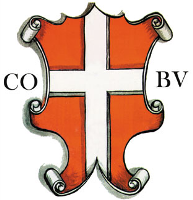 High and terrible mountains, Terrible and always filled with snow: this is how Leonardo da Vinci described these mountains, when he was in the entourage of beautiful Bianca Maria Sforza, who was travelling to meet her husband the emperor, travelled through these lands. We are in Bormio, in Valtellina, and we will take you to a tour to discover the rich history of this town, that in the past was called la Magnifica Terra (the Magnificent Land) and up to this day has kept this name.
Bormio is a very appreciated and visited thermal and ski resort, but what distinguishes it from all the other areas are the monuments and traces of its very ancient history. It seems that this alpine area was inhabited since the most remote times, perhaps by Liguri, Celts, Rhaetic or Etruscan; the transit of pre-roman populations in these lands is however confirmed by the discovery of important archaeological artifacts, mainly swords and axes, along with a precious fragment of a tablet from the IV-V century A.D. found near San Vitale Church. There isn't much evidence about Roman domination, but tradition assigns to this epoch some remnants of constructions near and around the Bagni Vecchi: we think that the Romans already knew of the positive effects of these waters, mentioned by Plinio il Vecchio.
The real history of Bormio however started in medieval times, when the village organized itself as a Town Council and, using its position as a strategic crossroads through the Alps, became autonomous, gained privileges and enriched itself thanks to commerce and taxes paid by travelers that crossed the passes. The period between the XIIIth and the XVth century was the most prosperous time of Bormio, during which the small village became a large town, rich in civilian and religious monuments, also inhabited by families of noble birth who defined themselves with pride as "Nobiles de Burmio". In the following centuries Bormio saw many foreign rules- the French one the Spanish one and, above all, the long domination by Grisons - before becoming part of the Repubblica Cisalpina (Trans-alpine Republic), then the Austro Hungarian one and at last the Kingdom of Italy. Each one of these epochs gave us important historical, artistic, cultural and architectural artifacts.
An important trace of Bormio's millenia spanning history is constituted by the artistic treasures preserved in its seven churches. The most ancient, The Collegiata, already existing in the IXth century, was rebuilt in the 1600 and inside is rich in stuccos, wood carvings and oil paintings. Among all the others, we note the San Vitale Church as the one that better preserves the medieval architecture and structure, the ex church of Santo Spirito, naked outside but decorated inside by pleasant frescoes recently restored, originally dated between the XIV and the XVI century and at the end the Church of S. Ignazio, typical baroque construction with an octagonal base and central dome also adorned with precious paintings, frescoes and carvings. Our trip will take us to the discovery of what we can still admire today about the numerous towers of the Magnificent Land, that define the look of the town since medieval times and often surprised visitors in both number and size.
High and terrible mountains, Terrible and always filled with snow: this is how Leonardo da Vinci described these mountains, when he was in the entourage of beautiful Bianca Maria Sforza, who was travelling to meet her husband the emperor, travelled through these lands. We are in Bormio, in Valtellina, and we will take you to a tour to discover the rich history of this town, that in the past was called la Magnifica Terra (the Magnificent Land) and up to this day has kept this name.
Bormio is a very appreciated and visited thermal and ski resort, but what distinguishes it from all the other areas are the monuments and traces of its very ancient history. It seems that this alpine area was inhabited since the most remote times, perhaps by Liguri, Celts, Rhaetic or Etruscan; the transit of pre-roman populations in these lands is however confirmed by the discovery of important archaeological artifacts, mainly swords and axes, along with a precious fragment of a tablet from the IV-V century A.D. found near San Vitale Church. There isn't much evidence about Roman domination, but tradition assigns to this epoch some remnants of constructions near and around the Bagni Vecchi: we think that the Romans already knew of the positive effects of these waters, mentioned by Plinio il Vecchio.
The real history of Bormio however started in medieval times, when the village organized itself as a Town Council and, using its position as a strategic crossroads through the Alps, became autonomous, gained privileges and enriched itself thanks to commerce and taxes paid by travelers that crossed the passes. The period between the XIIIth and the XVth century was the most prosperous time of Bormio, during which the small village became a large town, rich in civilian and religious monuments, also inhabited by families of noble birth who defined themselves with pride as "Nobiles de Burmio". In the following centuries Bormio saw many foreign rules- the French one the Spanish one and, above all, the long domination by Grisons - before becoming part of the Repubblica Cisalpina (Trans-alpine Republic), then the Austro Hungarian one and at last the Kingdom of Italy. Each one of these epochs gave us important historical, artistic, cultural and architectural artifacts.
An important trace of Bormio's millenia spanning history is constituted by the artistic treasures preserved in its seven churches. The most ancient, The Collegiata, already existing in the IXth century, was rebuilt in the 1600 and inside is rich in stuccos, wood carvings and oil paintings. Among all the others, we note the San Vitale Church as the one that better preserves the medieval architecture and structure, the ex church of Santo Spirito, naked outside but decorated inside by pleasant frescoes recently restored, originally dated between the XIV and the XVI century and at the end the Church of S. Ignazio, typical baroque construction with an octagonal base and central dome also adorned with precious paintings, frescoes and carvings. Our trip will take us to the discovery of what we can still admire today about the numerous towers of the Magnificent Land, that define the look of the town since medieval times and often surprised visitors in both number and size.
Nowadays Bormio is divided in five quarters, which recall the old boroughs of ancient times and each borough is represented by an symbol and a color:
- Buglio: has a fountain as a symbol and blue as a colour because there was an old big fountain.
- 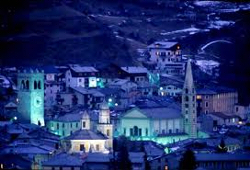 Dossiglio: has a mill wheel as a symbol and green as colour. It was so called because of the many mills in the area. Most of them have been lost today.
Dossiglio: has a mill wheel as a symbol and green as colour. It was so called because of the many mills in the area. Most of them have been lost today.
- Maggiore: has a wolf as a symbol and red as a colour, because the wolf, with its voracity, was testimony of the worse characteristics of the noble families that once resided mostly in this area.
- Dossorovina: has the main square as a symbol, displayed with the main tower and the Kuerc which are found in the middle of the Borough. Yellow is its colour.
- Combo: has a cat as a symbol and white as its colour. It is represented by a cat because the old nickname of gat (cat in local dialect) was given to the inhabitants of this area.
The various boroughs take part every year in several events that involve both residents and tourists: for example, the first week of February the Palio delle Contrade takes place, a competition involving cross country and downhill skiing and relay runs; while during Easter there is a parade, in Bormio's traditional clothes during which men carry on typical wooden home made sedans creations/statues with allegorical and/or religious meanings while women walk behind them with baskets containing the meaning of each Pasquale (the sedan/statue). The Pasquali Parade is an extremely ancient tradition; it seems it stems from ancient pagan rituals and alpine culture that then became popular as Christian rites.
Before going down to the ancient streets of the boroughs, we'll stop and have a look over the remains of San Pietro castle, that overlooks the whole town from here.
The Saint Pietros Castle
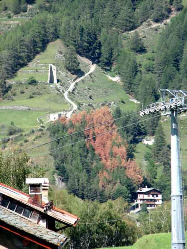 The very old castle was built-up on the side of the Reit mountain to protect Bormio. We have information starting from 1200.
The castle was destroyed in 1376 by the Visconti troops guided by Giovanni Cane. They arrived from Val Grosina and Val Viola catching the population of Bormio and pillaging the villages and the surrounding valleys.
Adjoining the castle there was a little church dedicated to the Saints Pietro, Paolo e Andrea that was gravely damaged from a fire in 1817; today few remains from the apsidal zone appear.
The rest of the squared tower of the castle is still visible; it was situated much more close to the plain, while the superior round tower collapsed in 1900.
The squared tower was built on more floors; the inferior level of the tower was limited with a barrel vault. On the first floor there was a wooden floor that delimitated another floor of the tower when it is still possible to see two very narrow embrasures. It is presumable that there was a third floor because a surviving wood testified the presence of a further wooden floor. On the north wall traces of a window and of the entrance are visible.
Some ruins of wallings, belonging to the basic structure, are the only evidence of the round tower. However, we can get an idea of its original appearance through a nineteenth-century photography, which shows it already badly damaged, but the battlements still intact. The wallings were built with little lime; the size of the tower was 7 metres diameter and 20 metres height. We dont have many information about this tower and the epoch in which it was built. The historian and archaeologist Gian Piero Bognetti assumed that the round tower was built during the Roman age.
The very old castle was built-up on the side of the Reit mountain to protect Bormio. We have information starting from 1200.
The castle was destroyed in 1376 by the Visconti troops guided by Giovanni Cane. They arrived from Val Grosina and Val Viola catching the population of Bormio and pillaging the villages and the surrounding valleys.
Adjoining the castle there was a little church dedicated to the Saints Pietro, Paolo e Andrea that was gravely damaged from a fire in 1817; today few remains from the apsidal zone appear.
The rest of the squared tower of the castle is still visible; it was situated much more close to the plain, while the superior round tower collapsed in 1900.
The squared tower was built on more floors; the inferior level of the tower was limited with a barrel vault. On the first floor there was a wooden floor that delimitated another floor of the tower when it is still possible to see two very narrow embrasures. It is presumable that there was a third floor because a surviving wood testified the presence of a further wooden floor. On the north wall traces of a window and of the entrance are visible.
Some ruins of wallings, belonging to the basic structure, are the only evidence of the round tower. However, we can get an idea of its original appearance through a nineteenth-century photography, which shows it already badly damaged, but the battlements still intact. The wallings were built with little lime; the size of the tower was 7 metres diameter and 20 metres height. We dont have many information about this tower and the epoch in which it was built. The historian and archaeologist Gian Piero Bognetti assumed that the round tower was built during the Roman age.
Bormio and its towers
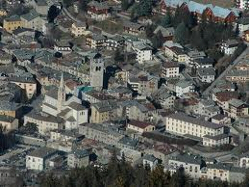 In the medieval age, according to a tradition handed down by some historians, in the village of Bormio were 32 towers, located near the palaces where the noble families of the age lived. It is unlikely that the towers were 32, but certainly from the XIIIth to the XIVth century, when the burg was rich and flourishing for the intensive commerce of transit across their mountains and their pass, these had been much less. During those centuries, in fact, it was spread the custom that the noble families or the rich merchants lived in homes like fortresses near powerful towers. The building towers had the function to defend and attack during the citizen fight or the external invasion, but they symbolized the riches and the power of the owners, too. During the Renaissance, the towers became a way to parade the nobility and the prestige of the family.
The towers were located not far one each others so that the owners could help each other during the enemies attacks. In fact it seemed that the towers were connected by subways that permitted the escape in dangerous situations. Their structure was distinguished by solid and square walls with windows with big iron bars and characteristic little windows with the function of spy and control on the low entrance doors.
It is difficult to say how many towers were still existing after the Spanish rule but it seems that in 1617 the towers were about 20.
Nowadays in Bormio we can see only 4 tower that are still existing: the Civic Tower, the Albertis Tower, the De Simonis Tower and the Pedranzinis Tower . Other elements of fortification remain also incorporated into later buildings. In the Quartiere degli Alberti in Dossorovina are the rests of construction at embattled towers, that we can see in the Castellazzi's home in Via San Francesco.
The old presence of towers can be supposed by some signs like the wall overhangs with large base and sometimes by the ashlared corners.
But now, we start our way among the still existing towers coming up to the principal square, Piazza del Kuerc.
In the medieval age, according to a tradition handed down by some historians, in the village of Bormio were 32 towers, located near the palaces where the noble families of the age lived. It is unlikely that the towers were 32, but certainly from the XIIIth to the XIVth century, when the burg was rich and flourishing for the intensive commerce of transit across their mountains and their pass, these had been much less. During those centuries, in fact, it was spread the custom that the noble families or the rich merchants lived in homes like fortresses near powerful towers. The building towers had the function to defend and attack during the citizen fight or the external invasion, but they symbolized the riches and the power of the owners, too. During the Renaissance, the towers became a way to parade the nobility and the prestige of the family.
The towers were located not far one each others so that the owners could help each other during the enemies attacks. In fact it seemed that the towers were connected by subways that permitted the escape in dangerous situations. Their structure was distinguished by solid and square walls with windows with big iron bars and characteristic little windows with the function of spy and control on the low entrance doors.
It is difficult to say how many towers were still existing after the Spanish rule but it seems that in 1617 the towers were about 20.
Nowadays in Bormio we can see only 4 tower that are still existing: the Civic Tower, the Albertis Tower, the De Simonis Tower and the Pedranzinis Tower . Other elements of fortification remain also incorporated into later buildings. In the Quartiere degli Alberti in Dossorovina are the rests of construction at embattled towers, that we can see in the Castellazzi's home in Via San Francesco.
The old presence of towers can be supposed by some signs like the wall overhangs with large base and sometimes by the ashlared corners.
But now, we start our way among the still existing towers coming up to the principal square, Piazza del Kuerc.
The Civic Tower
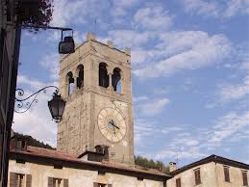 We are in the Kuerc square, the most important square in Bormio, where we can have with a single glance the most significant buildings in the old community of Bormio: on the left side of it, there is the Parish Church, on the right side there is the public building, in the middle there is the Kuerc (cover), the old canopy under which since the XIVth century the cities meeting happened and the justice was organized. On the left side of Kuerc, a big polygonal rock shows the place where up to the end of 700 there was the pillory, where the condemned were chained.
The Civic Tower, also called hour tower, with the Alberti Tower is one of the most beautiful examples of buildings still preserved in Bormio. The first certain news about the building date back to the end of the XIVth century, however it is certainly about an older building. During the centuries was repaired and edited many times, but it still keeps, today, traces of its original elements; in the north and in the west they preserved the older walls, while more recent are the south and east sides. The structure has a 8 metres side and it reaches about 30 metres about height. Inside the tower we find the famous Bajona, the bell which played to convoke the council of people or in case of fire or invasions.
The Bajona originally was kept in the castle of Saint Peter, and then after the invasion of viscounts of 1376, it was destroyed: they decided to recast it and put it on the Civic Tower. During the time that the bell was destroyed and recasted many times, it became the symbol for all the valley. Today, to preserve that symbol there is Coro della Bajona, the chorus of Bormio, that with its typical mountain songs cheer tourists and locals during the manifestations.
At the end of the XVth century the tower was elevated; a document of 1498, reserved at the Archive of State of Sondrio, it handed down a description of works make. Later was built a big wooden dome, whose aspect today can be deducted from a big banner of white silk and with colors of 1700, preserved in the Collegiata.
Above the Bajona there was a smaller bell, which served for the reunions of councils of the government. In the first half of 600, fire and looting caused damages to several buildings in the village, and certainly also to the Civic Tower: in fact in 1624 the Bajona had to be recast. The tower had been also damaged by the fire of 1855, one of the most disastrous of the century: in this occasion the tower lost some of its architectural entirety and all Dossorovina department was burned. The fire damaged the Kuerc, that currently preserves few traces of the old building. The Bajona provided the bronze for another smaller bell; the conic wooden dome was lost and it was not reconstructed anymore: the tower was covered with a normal roof with four slightly inclined slopes.
The Torre del Verona was located in the south-east corner of Piazza Maggiore until the last century when it shacked and only its base remained. This tower takes its name by his owners Verona and we remember it like an important building that soared on the roof's houses.
We are in the Kuerc square, the most important square in Bormio, where we can have with a single glance the most significant buildings in the old community of Bormio: on the left side of it, there is the Parish Church, on the right side there is the public building, in the middle there is the Kuerc (cover), the old canopy under which since the XIVth century the cities meeting happened and the justice was organized. On the left side of Kuerc, a big polygonal rock shows the place where up to the end of 700 there was the pillory, where the condemned were chained.
The Civic Tower, also called hour tower, with the Alberti Tower is one of the most beautiful examples of buildings still preserved in Bormio. The first certain news about the building date back to the end of the XIVth century, however it is certainly about an older building. During the centuries was repaired and edited many times, but it still keeps, today, traces of its original elements; in the north and in the west they preserved the older walls, while more recent are the south and east sides. The structure has a 8 metres side and it reaches about 30 metres about height. Inside the tower we find the famous Bajona, the bell which played to convoke the council of people or in case of fire or invasions.
The Bajona originally was kept in the castle of Saint Peter, and then after the invasion of viscounts of 1376, it was destroyed: they decided to recast it and put it on the Civic Tower. During the time that the bell was destroyed and recasted many times, it became the symbol for all the valley. Today, to preserve that symbol there is Coro della Bajona, the chorus of Bormio, that with its typical mountain songs cheer tourists and locals during the manifestations.
At the end of the XVth century the tower was elevated; a document of 1498, reserved at the Archive of State of Sondrio, it handed down a description of works make. Later was built a big wooden dome, whose aspect today can be deducted from a big banner of white silk and with colors of 1700, preserved in the Collegiata.
Above the Bajona there was a smaller bell, which served for the reunions of councils of the government. In the first half of 600, fire and looting caused damages to several buildings in the village, and certainly also to the Civic Tower: in fact in 1624 the Bajona had to be recast. The tower had been also damaged by the fire of 1855, one of the most disastrous of the century: in this occasion the tower lost some of its architectural entirety and all Dossorovina department was burned. The fire damaged the Kuerc, that currently preserves few traces of the old building. The Bajona provided the bronze for another smaller bell; the conic wooden dome was lost and it was not reconstructed anymore: the tower was covered with a normal roof with four slightly inclined slopes.
The Torre del Verona was located in the south-east corner of Piazza Maggiore until the last century when it shacked and only its base remained. This tower takes its name by his owners Verona and we remember it like an important building that soared on the roof's houses.
The Alberti's Tower
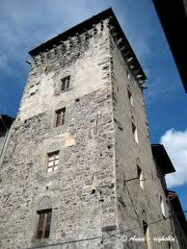 Alberti's Tower is situated along the Roma Street, in the past called also Mastra Street. The tower, also denominated Marioli Tower or Dossiglio Tower, was built at the end of the XIIIth century and belonged for many years to one of the noblest and most ancient Bormio's families, exactly the Albertis. The building reaches a twenty-four metres height and has a solid masonry with corners made of big rustication stones in different colours. Most of them are on grey-yellow-green coming from Bormio's valleys. The modern windows have partially hidden the ancient ones tracks of which on the south and west fronts are preserved too. Moreover, in the superior part, are still visible loop-holes on cross form and the shelves in stone in triple overhang that run all around the tower.
The building that for twenty years has given hospitality to the local Senior high school specializing in science education, doesn't conserve elements of its antiquity, in particular the wooden rooms present in the different floor were destroyed during the refurbishment when the tower was enriched of new openings.
Crossing the court beside the Alberti's Tower you can see the Alberti's Palace, a building of medieval origins rehandled many times in the course of the centuries. On the three sides of the building are still conserved some ancient and beautiful sun-dials, the sun-dial on the east-side (1656) is particularly curious because it is going to propose to the passer-by: This is my dear Sirs, your obligation, spending well that time that I show you here.
The tower remained famous to have given hospitality to important historical personages such as Bianca Maria Sforza, the niece of Ludovico Il Moro who in 1493 checked in Bormio with his army before to pass the Umbrail Pass and reached in Innsbruck her future husband Emperor Maximilian.
The springs of the epoch narrate that when the future emperor's wife will be passed, were systematized the demolished bridges, the ruined streets, built triumphal arches at the entrance of the village and searched to provide all the necessary for her and her procession of which made part among the others Milan's archbishop, the Como's bishop, some members of Sforza and Visconti families and, probably, Leonardo da Vinci, who from this trips would have drawn his personal impressions of Valtellina. In accordance with another supposition, Leonardo would have joined the Ludovico Il Moro's army, who went to Bormio three years later.
In 1496 Ludovico had also hospitality with his wife Beatrice in Dossiglio's Tower. Some notables from the village were elected with the job to be devoted of the preparation for the welcome of the dukes, who after three days took the way to Umbrail to reach Mals. On the way back Ludovico and Beatrice were accompanied at the Emperor Maximilian, who slept for four days in another house that belonged to Alberti's family, while in the village were organized merry-go-rounds and fighters as amusement for the renowned guests.
Alberti's Tower is situated along the Roma Street, in the past called also Mastra Street. The tower, also denominated Marioli Tower or Dossiglio Tower, was built at the end of the XIIIth century and belonged for many years to one of the noblest and most ancient Bormio's families, exactly the Albertis. The building reaches a twenty-four metres height and has a solid masonry with corners made of big rustication stones in different colours. Most of them are on grey-yellow-green coming from Bormio's valleys. The modern windows have partially hidden the ancient ones tracks of which on the south and west fronts are preserved too. Moreover, in the superior part, are still visible loop-holes on cross form and the shelves in stone in triple overhang that run all around the tower.
The building that for twenty years has given hospitality to the local Senior high school specializing in science education, doesn't conserve elements of its antiquity, in particular the wooden rooms present in the different floor were destroyed during the refurbishment when the tower was enriched of new openings.
Crossing the court beside the Alberti's Tower you can see the Alberti's Palace, a building of medieval origins rehandled many times in the course of the centuries. On the three sides of the building are still conserved some ancient and beautiful sun-dials, the sun-dial on the east-side (1656) is particularly curious because it is going to propose to the passer-by: This is my dear Sirs, your obligation, spending well that time that I show you here.
The tower remained famous to have given hospitality to important historical personages such as Bianca Maria Sforza, the niece of Ludovico Il Moro who in 1493 checked in Bormio with his army before to pass the Umbrail Pass and reached in Innsbruck her future husband Emperor Maximilian.
The springs of the epoch narrate that when the future emperor's wife will be passed, were systematized the demolished bridges, the ruined streets, built triumphal arches at the entrance of the village and searched to provide all the necessary for her and her procession of which made part among the others Milan's archbishop, the Como's bishop, some members of Sforza and Visconti families and, probably, Leonardo da Vinci, who from this trips would have drawn his personal impressions of Valtellina. In accordance with another supposition, Leonardo would have joined the Ludovico Il Moro's army, who went to Bormio three years later.
In 1496 Ludovico had also hospitality with his wife Beatrice in Dossiglio's Tower. Some notables from the village were elected with the job to be devoted of the preparation for the welcome of the dukes, who after three days took the way to Umbrail to reach Mals. On the way back Ludovico and Beatrice were accompanied at the Emperor Maximilian, who slept for four days in another house that belonged to Alberti's family, while in the village were organized merry-go-rounds and fighters as amusement for the renowned guests.
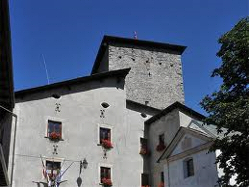
The De Simonis Tower
It takes its name by the family that come to Bormio from Valmalenco in the middle of the XVIth century. They became rich with the commerce, obtained titles and bought this big tower that had gone up again the XIII century. It had the function of medieval guaita. Near here there was the Palazzo de Simoni backing to the '600, today the seat of Civic Museum of Bormio.
The Pedranzinis Tower
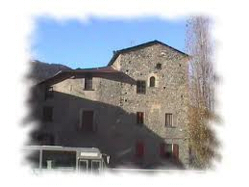 This is the Pedranzinis Tower that it is in the department of Buglio. It was built in the medieval period; on the north front there is a window in clear stone (probably Uzzas marble); on the east front there are other two windows, one with architrave and one curved, realized with the same stones, but currently are plug. There are a lot of loophole on the highest permanent structure while the lower parts are modified. In addiction on the wall there are corer stones with ashlars, rustically worked. On the main face there is a big wood main door that allowed the entrance of animals and wagons. On the hall the floor is cobbled paving. Here there is also the towns coat of arms with Leghe Grigie coat that represents the Lega Caddea, the Lega Grigia and the Lega delle dieci Giurisdizioni. They think that this place was used for the administration of the countryside. Outside there is a stone wall with an arch opening, that brings to the "Córt de li bescia", where the flocks were gathered.
Today the tower is known as Pedranzinis house because the famous patriot Pietro Pedranzini had inhabited there. He was born in Bormio in 1826 by humble family of peasants. When he was 22 years old he enlisted has volunteer for the defence of Passo dello Stelvio that was under threat by the Austrian. In 1859 the Garibaldis battalion I Cacciatori delle Alpi took possession of Bormio. In the same year Pedranzini with the help of colonel Nino Bixio, captured the Austrian unit near Bagni Vecchi. After the outbreak of the IIIrd war of independence, in 1866, Pietro captured, with only four men, 65 Austrians that was barricaded near of the I° road-menders house of Stelvio. After crossing the Reit mountain he arrayed his men to shout as much as possible and to roll many stones in order to make believe the Austrians to be surrounded. Pedranzini with this stratagem bursted in their refuge and took them. Thanks to this magnificent exploit he was called with the nickname Garibaldi della Reit and he was given the gold medal for the military valour.
This is the Pedranzinis Tower that it is in the department of Buglio. It was built in the medieval period; on the north front there is a window in clear stone (probably Uzzas marble); on the east front there are other two windows, one with architrave and one curved, realized with the same stones, but currently are plug. There are a lot of loophole on the highest permanent structure while the lower parts are modified. In addiction on the wall there are corer stones with ashlars, rustically worked. On the main face there is a big wood main door that allowed the entrance of animals and wagons. On the hall the floor is cobbled paving. Here there is also the towns coat of arms with Leghe Grigie coat that represents the Lega Caddea, the Lega Grigia and the Lega delle dieci Giurisdizioni. They think that this place was used for the administration of the countryside. Outside there is a stone wall with an arch opening, that brings to the "Córt de li bescia", where the flocks were gathered.
Today the tower is known as Pedranzinis house because the famous patriot Pietro Pedranzini had inhabited there. He was born in Bormio in 1826 by humble family of peasants. When he was 22 years old he enlisted has volunteer for the defence of Passo dello Stelvio that was under threat by the Austrian. In 1859 the Garibaldis battalion I Cacciatori delle Alpi took possession of Bormio. In the same year Pedranzini with the help of colonel Nino Bixio, captured the Austrian unit near Bagni Vecchi. After the outbreak of the IIIrd war of independence, in 1866, Pietro captured, with only four men, 65 Austrians that was barricaded near of the I° road-menders house of Stelvio. After crossing the Reit mountain he arrayed his men to shout as much as possible and to roll many stones in order to make believe the Austrians to be surrounded. Pedranzini with this stratagem bursted in their refuge and took them. Thanks to this magnificent exploit he was called with the nickname Garibaldi della Reit and he was given the gold medal for the military valour.